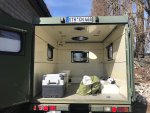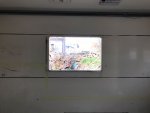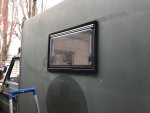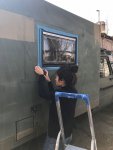WATEPROOFING
This is kind of a boring topic, so if it has no relevance to you just skip this post, but ask anyone with a camper (built or bought) for their story about leaks and they will have one. Even on our FWC we had a leak that took us several months and multiple FWC dealerships to find and fix. So as soon as I cut out the roof and created several seams I was worried about waterproofing.
In Europe, Sika 221i is basically what campers are made of. It's the glue that holds everything together and the seal that keeps water out of FRP panel bodies, roof vents, etc. I can't even begin to imagine how many tubes of this I have in the truck to date. It's great stuff. I had gotten really confident with it since I knew that my windows were water tight.
When the first big rain came after I had installed the roof I was only a little nervous. I drove across Berlin in a serious downpour and when I opened up the box it seemed fine at first. But under closer inspection I found a small amount of water leaked all around the bottom of the new curb for the pop top. My mind was blown. The seal looked so good! I asked an experienced builder and he told me to put a LOT of Sika. I increased my bead from less than one cm to about 2 cm. It was a huge bead. After the next big rain I found that the seal had improved, but a small amount or water was still coming through in many places. I am still in disbelief, that this happened, and why it happened.
I made this discovery when I tried to paint over a vent that I installed with a Sika bead around it. Remember when I said that the brand of spray paint was important? Well, when I sprayed over this Sika bead I noticed that the paint melted the Sika! This was probably the most ridiculous disaster of the build. I had painted my whole pop-top with this paint that melts Sika. When I inspected the Sika more carefully I found that it could just peel right off with almost no effort. Keep in mind that this stuff is usually bonded like epoxy and when it's dry it has a rubber tire like texture.
This lead to an arduous, multi day, process of removing all of the Sika along the bottom of the pop-top, wire wheeling all of the paint off of the bottom of the profile and re-applying to the bare aluminum. It seems to have fixed the problem, but with this issue definitely had me feeling like there were unseeable forces working against me. I consulted with all of the most experienced people I know, and none of them could believe it. I still don't know what the base of this sparVar spraypaint is, or the chemical reason this happens, but one thing is 100% sure:
NEVER COMBINE THESE TWO PRODUCTS!!!
It's too bad because this paint looks amazing and comes in the period correct German army Bronze Green color.
Luckily I was able to solve this before installing all of my plywood furniture panels. No harm done, but probably a week or so added to the duration of the project.


Oh, and here's a pic of the said rain storm where I was easily able to discover any possible leak:













































